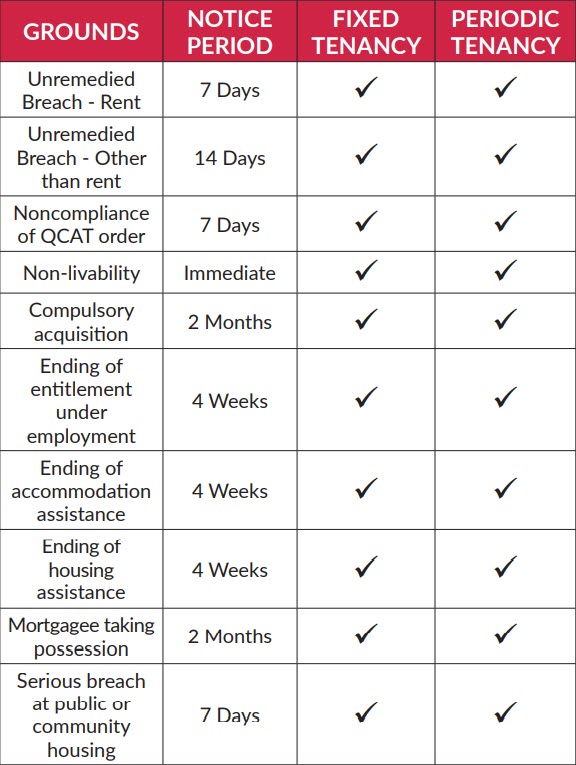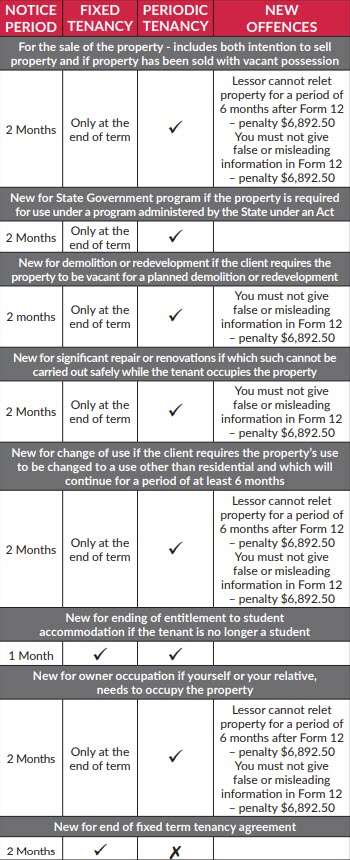Changes of Stage 1 of the RTRA Act on 1st October 2022 in Queensland
What YOU need to know about changes to the Residential Tenancies & Rooming Act from 1 October 2022
Tenants, Property Managers and Landlords should review Queensland's upcoming rental law changes, so they understand how their rights and responsibilities will change.
Key changes relate to:
- The grounds for ending fixed term and periodic tenancies have changed
- The right of a lessor to end a periodic tenancy without grounds has been removed and from 1 October 2022, lessors can only end a periodic tenancy for specific prescribed grounds under the RTRA Act.
- There are new offence provisions and penalties if a Form 12 Notice to Leave is issued on grounds and limitations are not complied with.
- There are new grounds for a tenant to end a tenancy within the first 3 months by application to QCAT for false and misleading information given by a property manager or lessor about certain matters.
- There will be an Expansion of grounds for tenant’s right to issue Form 13 Notice of Intention to Leave.
- There are new grounds for lessor to make a QCAT application to end a tenancy.
- Properties can no longer be advertised as “no pets allowed”.
- Lessors must respond to a pet request within 14 days – or their approval will be deemed granted.
- Lessors can only refuse a pet request on prescribed grounds, and they must give reasons to tenant for why they believe those grounds apply.
- Lessors can impose conditions on a pet approval in line with the prescribed requirements.
Tenants and property managers are now able to arrange emergency repairs to be made to the property up to a maximum amount equal to four (4) weeks’ rent under their tenancy agreement (increased from two (2) weeks’ rent).
- The Form 18a General Tenancy Agreement must identify nominated repairers and whether they are the tenant’s first point of call for emergency repairs.
- There are new requirements for the tenant to contact the nominated repairer before arranging for another repairer to carry out emergency repairs.
- A new type of QCAT order will be introduced – Repair Order.
- A tenant can apply if a property or inclusions need repairs that fall into category of routine or emergency repair.
- Outstanding Repair Orders must be disclosed in Form 18a General Tenancy Agreement.
- A property cannot be lawfully leased while a Repair Order is outstanding.
- New procedure and requirements for changing locks.
- Expanded retaliation provisions related to repair matters.
- Domestic & Family Violence provisions
- Minimum Housing Standards coming into effect on 1 September 2023 for new tenancies and 1 September 2024 for existing tenancies.
- New provisions for death of a sole tenant and co-tenant.
- Entry condition reports.
FAQ: Ending a Tenancy
1. What are the changes to the RTRA Act in relation to ending tenancies?
Lessors can no longer end periodic term agreements without grounds from 1 October 2022. Lessors may only end a periodic tenancy if they can satisfy one of the prescribed grounds as set out below;
2. What are the new reasons for a lessor to end a tenancy and prescribed notice periods?
The current grounds for a lessor to end a tenancy which will continue without change from 1 October 2022 are:

Source: REIQ
The additional new grounds to end a tenancy from 1 October 2022 and related offence provisions are:

Source: REIQ
There are also new grounds for a lessor to end tenancies by making an application to QCAT.
A non-urgent application can be made for a serious breach. This includes if lessor reasonably believes tenant or guest has:
- used the property for an illegal purpose (for example drug activity);
- intentionally or recklessly destroyed or damaged the property;
- endangered another person in the property; or
- significantly interfered with the reasonable peace, comfort, or privacy of another tenant by a tenant, occupant or guest.
The lessor may also make an urgent application to end a tenancy if there has been repeated breaches of by-laws or park rules by the tenant.
3. What are the new reasons for a tenant to end a tenancy and prescribed notice periods?
The grounds for a tenant to issue a notice of intention to leave have now been expanded.
Within the first 3 months of a tenancy, the tenant can now apply to QCAT for a termination order if the lessor or property manager gave the tenant false or misleading information about:
- the condition of the property or its inclusions; or
- the services provided for the property; or
- a matter relating to the property that is likely to affect the tenant’s quiet enjoyment of the property; or
- the tenancy agreement or any other document the lessor must give the tenant under the RTRA Act – such as body corporate by-laws; or
- the rights and obligations of the tenant or lessor under the RTRA Act. The grounds for a tenant to issue a Form 13 Notice of Intention to Leave have also been expanded. Within the first 7 days of a tenancy, the tenant can issue a Form 13 Notice of Intention to Leave to the lessor because:
- the property is not fit for the tenant to live in; or
- the property and inclusions are not in good repair; or
- the lessor is in breach of a law dealing with issues about the health or safety of persons using or entering the property; or
- the property or inclusions do not comply with the prescribed Minimum Housing Standards which come into effect 1 September 2023 for new tenancies and 1 September 2024 for existing tenancies.
It is important to make sure lessors are aware of these grounds – particularly if you have reason to believe that the property is not in a good condition or repair at the start of the tenancy. Please note the above is subject to change when the minimum housing standards come into effect from 1 September 2023.
4. What should I do if I have periodic tenancy on my rent roll?
Your clients will need to be aware that if a periodic tenancy continues after 1 October 2022, then they can only end the tenancy for a limited number of prescribed reasons. If no action is taken, your client may be locked into the tenancy for an indefinite period. If your client chooses to keep the tenant on a periodic agreement, they should contact their insurer to confirm if this will affect their insurance cover.
5. How will this affect fixed term agreements on my rent roll?
Fixed term agreements can still be ended with at least two months’ notice however, a lessor will no longer be able to end a tenancy without grounds from 1 October 2022. Instead, if a lessor wishes to end a tenancy at the end of the agreed fixed term (and not renew), a Form 12 Notice to Leave must be given on the grounds that the tenancy is ending or on some other available grounds for ending a tenancy. If the Form 12 Notice to Leave is not given with the correct notice period (having regard to delivery times as well) then the fixed term agreement will automatically convert to a periodic tenancy at the end of the fixed term.
If you have fixed term agreements, we recommend issuing the Form 12 Notice to Leave well in advance of the expiry of the fixed term tenancy which can be given with or without an offer of a new tenancy. You should seek your clients’ instructions about offering a new tenancy at least 3 months before the end of the tenancy. This is to allow time for the client to make their decision and for you to prepare and issue the appropriate documents.
If a new Form 18a General Tenancy Agreement is being offered to the tenant, we recommend a Form 12 Notice to Leave be issued at the same time with the vacating date being the expiry date of the current term. The offer of a new tenancy should have a deadline for the tenant to accept the offer so that if they do not, then they are required to vacate the property on the expiry date of the current term. If this step is not taken, the tenancy may automatically convert to a periodic tenancy.
6. If I issue a valid Form 12 Notice to Leave without grounds (NTLWG) before 1 October 2022, will it be valid and can I rely on it after 1 October 2022?
Section 570 of the Transitional Provisions for the Housing Legislation Amendment Act, relates to notices issued prior to 1 October 2022.
If a NTLWG was given to a tenant under a period agreement on 1 September 2022, providing the required 2 months’ notice with a handover day of 1 November 2022 (in accordance with section 329(2) (j)), then this is the initiating action in accordance with section 570(1)(a).
The responder in this instance is the tenant and the action the tenant must take is to vacate the property by 1 November 2022. This obligation/action continues beyond 1 October 2022.
If the tenant does not vacate the property on or before 1 November 2022, then the lessor may apply to QCAT, within 2 weeks of 1 November 2022, for a termination order in accordance with section 293 of the RTRA Act for failure to leave.
FAQ: Pet Approvals and Refusals
1. What are the changes to the RTRA Act in relation to pets?
From 1 October 2022 include:
- lessors must have a specific reason under prescribed grounds in order to refuse a tenant’s request to keep a pet – they can no longer say “no pets allowed” or apply a blanket pet prohibition
- conditions for keeping a pet at a property must comply with prescribed requirements
- a new definition for pets has been introduced with a clarification about working dogs
2. What do I need to do if I receive a request from a tenant to keep a pet?
If you receive a pet request from a tenant after 1 October 2022, you must respond to the tenant’s request within 14 days after receiving it. The response must be in writing and state whether the lessor approves or refuses the request, and:
- if approved, what the conditions of approval are; or
- if refused, the grounds for the refusal – these grounds must be limited to those permitted under the RTRA Act and why you believe the grounds for the refusal apply. If you do not respond in time or your response is not compliant, the lessor’s approval will be deemed. This means that the tenant is entitled to assume approval has been granted and they can keep a pet/s at the property without conditions.
3. What if I receive a pet request in the meantime?
You may wish to start implementing procedures in your agency prior to 1 October 2022 so that your clients are ready for the changes.
4. What are the new prescribed forms and resources?
There will be a prescribed pet request form that the tenant must use after 1 October 2022. There will also be a prescribed pet approval and refusal form that you must use after 1 October 2022 when responding to the tenant’s request.
5. What is the new definition of a “pet”?
It is important to note that a “pet” is now defined as a domesticated animal or animal that is dependent on a person for provision of food or shelter. A pet does not include a working dog or animal prescribed by legislation not to be a pet.
A working dog can be kept on the property without your client’s approval. The tenant is not responsible for damage caused by a working dog at the property – it is considered fair wear and tear.
Further, a “working dog” includes:
- an assistance dog, guide dog or hearing dog under the Guide, Hearing and Assistance Dogs Act 2009, schedule 4; or
- a corrective services dog under the Corrective Services Act 2006, schedule 4; or
- a police dog under the Police Powers and Responsibilities Act 2000, schedule 6.
If the request relates to a pet that does not fall into the category of working dog but still provides a service for the tenant, such as a mental health pet, then you should advise your client to seek legal advice about refusing the request. You should exercise caution as a refusal may equate to discrimination in some circumstances.
6. What are the prescribed grounds to refuse a pet request?
From 1 October 2022, if the client refuses a pet request, it is no longer sufficient or permissible to say, “no pets allowed”.
Under the new provisions of the RTRA Act, the permitted grounds to refuse a pet request are limited to the following:
- keeping the pet would exceed a reasonable number of animals being kept at the property;
- the property is unsuitable for keeping the pet because of a lack of appropriate fencing, open space or another thing necessary to humanely accommodate the pet;
- keeping the pet is likely to cause damage to the property or inclusions that could not practicably be repaired for a cost that is less than the amount of the rental bond for the property;
- keeping the pet would pose an unacceptable risk to the health and safety of a person, including, for example, because the pet is venomous;
- keeping the pet would contravene a law;
- keeping the pet would contravene a body corporate by-law or park rule applying to the property;
- the tenant has not agreed to the reasonable conditions proposed by you for approval to keep the pet;
- the animal stated in the request is not a pet; or
- if the property is a moveable dwelling property— that keeping the pet would contravene a condition of a licence applying to the property.
7. What conditions can we include for an approval?
The client may approve a pet request subject to conditions. The conditions must:
- relate only to keeping the pet at the property; and
- be reasonable having regard to the type of pet and the nature of the property; and
- be stated in the written approval given to the tenant.
Without limiting what conditions are reasonable having regard to the type of pet and the nature of the property, the RTRA Act prescribes that the following conditions are taken to be reasonable:
- if the pet is not a type of pet ordinarily kept inside—a condition requiring the pet to be kept outside at the property;
- if the pet is capable of carrying parasites that could infest the property—a condition requiring the property to be professionally fumigated at the end of the tenancy; and
- if the pet is allowed inside the property—a condition requiring carpets in the property to be professionally cleaned at the end of the tenancy.
The authorisation to keep a pet or working dog at the property continues for the life of the pet or working dog and is not affected by the agreement changing if the tenant still occupies the property, a change in lessor or property manager, or the retirement of the working dog.
An authorisation to keep a pet, working dog or other animal at property is also subject to any body corporate by-law, park rule or other law relating to keeping animals at the property.
8. What if the tenant disagrees with the grounds of refusal or conditions for approvals?
If the tenant does not agree with the grounds of refusal or conditions of approval provided in the lessor’s response it can only be properly tested in QCAT.
9. Does this apply for new tenancies? Do we have to follow this process for a tenant with a pet applying for a property?
These requirements will apply for all tenancies from 1 October 2022.
10. Can we request more rent or a higher security bond if the tenant wants to keep a pet?
Your client is not allowed to increase rent or the security bond if the tenant wants to keep a pet on the property. If they are concerned that any damage caused may be higher than the bond they hold, they may be able to refuse the tenant’s request under the relevant prescribed grounds.
FAQ: Matters Affecting Repairs
1. What are the changes to the RTRA Act in relation to repairs?
Some of the changes to the tenancy laws relate to the process and authorisation for repairs, including:
- increasing the maximum spending amount allowed for a tenant or property manager for emergency repairs from two (2) weeks to four (4) weeks’ rent;
- the Form 18a General Tenancy Agreement must now identify the nominated repairer that is the tenant’s first point of call for emergency repairs;
- new provisions replacing the process for obtaining and dealing with an order of QCAT for carrying out emergency & routine repairs – now referred to as “Repair Orders”;
- an outstanding Repair Order made by QCAT applying to a property must be disclosed in the Form 18a General Tenancy Agreement to the tenant prior to the tenant entering into the tenancy; and
- any repairs for damage to the property which are caused by domestic violence experienced by the tenant is the responsibility of the lessor and costs cannot be recovered from the tenant.
2. What is the difference between an emergency repair and a routine repair?
“Emergency” repairs include:
- a burst water service or serious water service leak;
- a blocked or broken lavatory system;
- a serious roof leak;
- a gas leak;
- a dangerous electrical fault;
- flooding or serious flood damage;
- serious storm, fire or impact damage;
- a failure or breakdown of the gas, electricity or water supply to the property;
- a failure or breakdown of an essential service or appliance on the property for hot water, cooking or heating;
- a fault or damage that makes the property unsafe or insecure;
- a fault or damage likely to injure a person, damage property or unduly inconvenience a resident of the property; or
- a serious fault in a staircase, lift or other common area of the property that unduly inconveniences a resident in gaining access to, or using, the property.
All other repairs are considered to be “routine” repairs and maintenance.
This is subject to change once the minimum housing standards come into effect for new tenancies from 1 September 2023 and existing tenancies from 1 September 2024.
From 1 October 2022, a lessor must provide details of nominated repairers in the Form 18a General Tenancy Agreement.
Although, your office can be listed as the “nominated repairer” for the purpose of the Form 18a General Tenancy Agreement, it is recommended to insert the contact details of the specific nominated repairer, as authorised by your client under the PO Form 6, so that the tenant has a contact outside of business hours. It is also recommended that your client authorises you to engage your agency preferred nominated repairers under the PO Form 6 so that you can ensure the repairers provide the Contractor Appointment Form, are qualified and reputable, and hold the requisite insurance.
FAQ: Repair Orders
1. What is the new process?
A tenant can apply to QCAT for a repair order if the property or inclusions need repair. If they are routine repairs, the tenant must have informed you of the need for repair and the repair must have not been carried out within a reasonable time after you were informed.
For emergency repairs, the tenant must have been unable to notify you or the nominated repairer of the need for repair or the repair must have not been made within a reasonable time after the tenant gave you or the nominated repairer notice of the need for repair. From 1 October 2022, a lessor must provide details of the nominated repairers in the Form 18a General Tenancy Agreement.
2. What will QCAT consider when making repair orders?
QCAT may grant a repair order if they are satisfied with the tenant’s application. They must consider:
- the conduct of the lessor or the property manager
- the risk of injury the damage is likely to cause a person at the property
- the loss of amenity caused by the damage
- or any other matter QCAT considers relevant
3. What will a repair order include?
In granting the repair order, QCAT may make any order, or give any directions, about the repairs that QCAT considers appropriate in the circumstances. If the property is vacant, QCAT may make an order that the property not be occupied until stated repairs are completed.
QCAT may also make an order about:
- what is, or is not, to be repaired
- that the lessor must carry out the repairs by a stated date
- that the tenant may arrange for a suitably qualified person to carry out the repairs for an amount decided by the tribunal
- who must pay for the repairs
- that the tenant may pay a reduced rent until the repairs are carried out to the standard decided by the tribunal
- that the lessor must pay an amount to the tenant as compensation for loss of amenity
- that a suitably qualified person must assess the need for the repairs or inspect the property or inclusions
- that the residential tenancy agreement ends if the repairs are not completed by a stated date If QCAT makes a repair order against your client, you should recommend they seek legal advice about what the order requires them to do and the consequences of failing to comply.
4. What happens if the order is not complied with?
Until complied with, the repair order continues to apply to the property. It does not end with the residential tenancy agreement pursuant to which the tenant application arose. From 1 October 2022, there will be an obligation to disclose outstanding repair orders in a general tenancy agreement.
A person must comply with a repair order unless they have a reasonable excuse. It is an offence under the RTRA Act to fail to comply. The responsible party may be fined.
5. What if the lessor needs an extension?
The lessor may apply to QCAT for an extension of time to comply with a repair order. QCAT may grant the application if they are satisfied the lessor is unable to complete the ordered repairs before the required time due to:
- hardship
- a shortage of a material necessary to make the repairs
- the remote location of the property causing the lessor difficulty in being supplied with a material necessary to make the repairs or engaging a suitably qualified person to make the repairs.
FAQ: Changing Locks
1. What are the changes to the RTRA Act in relation to changing locks?
The grounds to change a lock has been expanded, it is now separate grounds “if the party has a reasonable excuse” and “if the party believes there is an emergency”. There is also a new ground for changing a lock – if the tenant believes the change is necessary to protect themselves or another occupant from domestic and family violence and has engaged a qualified locksmith.
In addition, there is also a new requirement that a lessor cannot provide a copy of the key to another party without consent of the tenant if a lock is changed by the tenant under the domestic and family violence grounds. The lessor is still obligated to ensure the property is kept secure.
2. When can a party change a lock?
A lessor or tenant may only change a lock if:
- the parties have agreed to the change;
- the party has a reasonable excuse for making the change;
- the party believes the change is necessary because of an emergency; or
- the lock is changed pursuant to a QCAT order. Tenants may also change a lock if the tenant believes the change is necessary to protect themselves or another occupant from domestic and family violence and engages a qualified locksmith to change the lock.
3. What is a “reasonable excuse”?
“Reasonable excuse” is not defined in the RTRA Act but might include circumstances where: • the tenant has lost/damaged the keys and/or devices – the locks should be replaced for security purposes;
- the lessor wants to upgrade/replace the locking mechanisms or fixtures the locks are attached to; or
- a tenant leaves the property.
4. What would be classified as an “emergency”?
“Emergency” is not defined in the RTRA Act but might include circumstances where it is necessary to secure the property if:
- the locks are damaged and the tenant cannot access the property; or
- the property has been broken into or there has been some other unathorised entry.
5. What if one party will not agree to change the locks?
The parties must not act unreasonably in failing to agree to the change of a lock. This is a legislative requirement under s212 of the RTRA Act and standard term 21 of the Form 18a General Tenancy Agreement.
If the lessor or tenant is refusing to agree to change a lock, property managers should remind them of their obligations under the RTRA Act and Form 18a General Tenancy Agreement.
If you believe the client has a reasonable ground to refuse consent such as if the tenant’s grounds for the change are not covered under the RTRA Act, you should notify the tenant of why the request is refused.
6. What if the lock has been changed by a person that is not qualified?
The locks should only be changed by a qualified locksmith. The parties must not change the locks themselves. You should seek confirmation from the client or tenant if they have changed a lock. If it appears that the lock has not been professionally changed, you should seek your clients’ instructions as the change of lock may affect their insurance cover.
7. When should a tenant provide a copy of the new keys and/or devices?
If the tenant has changed the locks under valid grounds, they must provide a copy of the key and/ or devices to your office. It is recommended that the property manager request a copy of the keys and/ or devices immediately upon learning of the change of locks. If the tenant fails to provide the keys after a request is made, the property manager should consider issuing a Form 11 Notice to Remedy Breach.
8. If the property manager or lessor changes a lock, when should the lessor or property manager provide the keys to the tenant?
You should provide all keys and/or devices to the tenant as soon as practicable so that they continue to have access to the property. You should try to arrange any lock change on behalf of the lessor at a time that is suitable for the tenant so that they can immediately take a copy of the key. If there is a delay in providing the keys to the tenant, this may be a breach of the Form 18a General Tenancy Agreement and RTRA Act as the tenant’s access to the property or that part of the property may be affected.
9. Who pays for the change of a lock?
In most circumstances, the party that is responsible for the change of a lock or wishes to change a lock will be the party responsible for the cost. There may be some circumstances where a specific party is responsible, such as:
- if a lock needs to be replaced because it is damaged by the tenant, then the tenant is responsible;
- if a lock needs to be replaced due to fair wear and tear, then the lessor is responsible;
- if the lock is replaced because a key is lost or damaged by the tenant, then the tenant is responsible;
- if the lock is replaced because of a change in tenants, the lessor is responsible for the cost; and
- if there has been an unforced entry and a police report, the lessor is responsible for the cost. A tenant may also change a lock at the property if they believe it is necessary to protect themselves or another occupant of the property from domestic violence.
10. Is there anything else I need to do?
Property managers should remind their lessor:
- to speak to their insurer if major changes have been made to the property; and
- if the property is a lot in a Community Titles Scheme, to review by-laws of the body corporate or other rules in place.
FAQ: Minimum Housing Standards
1. What are the changes to the RTRA Act with respect to minimum housing standards?
The following minimum housing standards are prescribed by the RTRA Act which shall come into effect on 1 September 2023 for new tenancies and 1 September 2024 for existing tenancies. Once these standards are in effect, a lessor is obligated to keep the repair and condition of the property to these standards. The definition of emergency repairs will also be expanded to incorporate the matters contained in minimum housing standards.
2. What will the minimum housing standards be?
The prescribed minimum housing standards that will come into effect are set out in the Housing Legislation Amendment Act 2021. Although subject to change, they are currently:
a) The property must be weatherproof, structurally sound and in good repair
- the roofing and windows must prevent water from entering the property when it rains
- a property is not structurally sound if:
- a floor, wall, ceiling or roof is likely to collapse because of rot or a defect; or
- a deck or stairs are likely to collapse because of rot or a defect; or
- a floor, wall or ceiling or other supporting structure is affected by significant dampness; or
- the condition of the property is likely to cause damage to an occupant’s personal property.
b) The fixtures and fittings for the property must be in good repair
- includes electrical appliances
- must not be likely to cause injury to a person through the ordinary use of the fixtures and fittings
c) The external windows and doors must have functioning locks
- must secure the property against unauthorised entry
- only to the windows and doors that a person outside the property or room could access without having to use a ladder
d) Property must be free from vermin, damp and mould
- does not apply if caused by the tenant, including, for example, caused by a failure of the tenant to use an exhaust fan installed at the property
e) Property must have privacy coverings for windows in all rooms which tenant would reasonably expect privacy
- privacy coverings for windows include blinds, curtains, tinting and glass frosting
- does not apply if a line of sight between a person outside the property and a person inside the room is obstructed by a fence, hedge, tree or other feature of the property
f) Property must have adequate plumbing and drainage
- must be connected to a water supply service or other infrastructure that supplies hot and cold water suitable for drinking
g) Bathrooms and toilets must be private, toilets must function as designed and be connected
- each toilet must function as designed, including flushing and refilling, and be connected to a sewer, septic system or other waste disposal system
h) Kitchen (if there is one) must include a functioning cook-top
i) Laundry must include fixtures required to provide
FAQ: Domestic & Family Violence Provisions
1. What are the new provisions relating to Domestic and Family Violence?
The new provisions for domestic and family violence were introduced when the Housing Legislation Amendment Act came into effect on 1 October 2021. These provisions are currently in place and a number of prescribed forms are available from the Residential Tenancies Authority (RTA), which must be used. Property managers should always exercise caution when dealing with tenants that are experiencing domestic and family violence.
Other Changes
Death of Sole Tenant or Co-Tenant
From 20 October 2021, if a sole tenant dies, the tenancy ends one month after the persons death, or earlier if:
- the lessor and tenant’s representative agree to an end date; or
- 14 days after either party gives the other written notice of the agreement ending because of the tenant’s death; or
- a day decided by QCAT if the lessor makes an urgent application under s415(5) of the RTRA Act.
If a co-tenant dies, their interest in the tenancy ends and the agreement continues in force with parties to the agreement.
There are now new grounds allowing a remaining co-tenant to end their tenancy if their co-tenant dies and continuing the tenancy would be impractical for that remaining co-tenant or would cause them excessive hardship. The tenant can end their tenancy by giving a Form 13 Notice of Intention to Leave to the lessor, with a notice period of 14 days.
If you are informed that a tenant has passed away at the property, if the tenant was a sole tenant, we recommend contacting their emergency contact as soon as practicable. If the tenant was a co-tenant, we recommend contacting the remaining co-tenants in a timely manner to confirm what they would like to do.
Entry Condition Reports
From 1 October 2022, the tenant will now have 7 days to sign, return and raise dispute with the entry condition report, increased from 3 days. The 7 days will commence from the date the tenant first occupies the property. If the tenant enters a new tenancy agreement to continue their interest after the expiry of their current tenancy agreement for the same property, unless a new entry condition report is prepared, the original condition report is taken to be the condition report for the renewed agreement.
You should ensure that your internal processes are changed to keep compliant with the new time limit.
Contact Information
If you have any questions or need any guidance as it relates to these legislation changes, please contact our National Property Manager, Debbie Fletcher at the below details:
Email - debbie.fletcher@firstnational.com.au
Mobile - 0413 624 307








